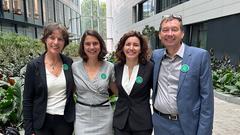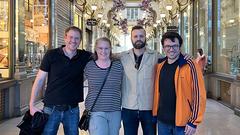The IDEAA team: (from left) Saša Bajt, Nina Rohringer, Francesca Calegari, and Henry Chapman Photo: private
Synergies abound: six DESY scientists at the German research centre DESY in Hamburg have been awarded the highly competitive European Research Council (ERC) Synergy Grants for two ambitious research programmes. These grants are among the most prestigious offered in the European Union, recognizing outstanding scientific excellence and unique collaboration.
The total funding of €19.3 million over six years will enable the groups to expand their teams, develop cutting-edge instrumentation, and steer their research into new directions in through these two ambitious, high-risk research programmes. Each programme is led by four principal investigators (PIs), with one team consisting exclusively of DESY lead scientists – marking the first ERC Synergy project where all four PIs are affiliated with the same host institution within the Helmholtz Association.
Both funded projects strive for significant scientific milestones. The team comprising Saša Bajt, Francesca Calegari, Henry Chapman, and Nina Rohringer is awarded 14 million euro for DESY and will combine atomic-scale imaging with the Nobel Prize-winning field of attosecond science, the most advanced ultrafast imaging of matter in science. The other team is a collaboration between DESY scientist Jenny List and lead scientist Andreas Maier alongside Henri Vincenti from the French research organization CEA and Antonino Di Piazza from the University of Rochester in the USA. This programme, also funded with 14 million euro of which 5.3 million will go to DESY, will investigate the quantum fundamentals of the electromagnetic force, one of the universe’s four basic forces, by generating extremely high electric fields using plasma accelerators and high-powered lasers.
The European Research Council (ERC) is the premier research funding body for frontier research in the EU. The ERC Synergy Grants are particularly prestigious as they require exceptional interdisciplinary collaboration. With only 66 projects funded out of 701 applications in 2025 (a success rate of just 9.4%), these awards position the recipients among Europe's top researchers. The grants not only provide substantial funding but also carry significant prestige, enhancing the international reputation of both the individual researchers and DESY as a leading research institution.
“Research at DESY is not only excellent but diverse, as these two ERC Synergy Grants make clear,” says DESY Chair of the Board of Directors Beate Heinemann. “Our scientists have brought together themes, methods, and theories present in different parts of our research centre and proposed novel collaborative plans to develop new technologies for the understanding of matter. I was particularly amazed that one of the grants was awarded to four DESY scientists that formed a team. My warmest congratulations to all researchers involved in both grants, and most of all I wish them all the best in achieving their research goals!"
The winning research teams will use the funding over the next 72 months to make new doctoral and postdoctoral positions and develop new instrumentation. For the researchers who proposed the two projects, their goal is to develop tools that others in their fields can use to approach new research questions and make definitive advancements in answering long-lingering questions about the nature of matter. Additionally, both teams aim to provide benchmarks to longstanding theories using direct evidence provided through the new methods they will develop.
MORE ABOUT THE WINNING RESEARCH PROGRAMMES
The ultrafast meets the ultrashort: IDEAA
Four DESY lead scientists and members of the University of Hamburg CUI Excellence Cluster Advanced Imaging of Matter (AIM) initiated the winning IDEAA (Imaging the Dynamics of Electrons at Attosecond and Ångstrom resolution) project: Saša Bajt, Francesca Calegari, Henry Chapman, and Nina Rohringer. The goal of the team is to observe the motions of electrons within complex organic molecules. This information would be the key to understanding fully the electronic fundamentals of chemistry, a major step towards the controlling of chemical reactions: a paradigm shift in our understanding of nature, but also in chemical engineering, drug development, industrial processes, and much more. IDEAA is awarded nearly 14 million euro.
“We pioneered the use of attosecond light sources to ‘film’ the ultrafast migration of electronic charge occurring in complex molecules. However, these movies of electron dynamics have only been produced by combining theory and indirect spectroscopic observation in experiments,” says Francesca Calegari, lead scientist at DESY, professor of physics and speaker of CUI at the University of Hamburg, lead of the Attosecond Science group at the Center for Free Electron Laser Science (CFEL). “We want to directly produce these movies out of our measurements.”
Attosecond science, which was the subject of the 2023 Nobel Prize in Physics, enables such direct observations. Electron motion becomes clearer at the attosecond scale – a billionth of a billionth of a second – but the challenge for the team is showing this at the scale of an Ångstrom, a length equal to a ten-billionth of a metre. An Ångstrom is the at scale of the radius of a single atom. “We want to be able to watch how chemistry happens at the atomic scale, and using new capabilities at X-ray free-electron lasers and tabletop lasers, we now can get to those time scales,” says Henry Chapman, lead scientist at DESY, a professor of physics and speaker of CUI at the University of Hamburg, lead of the Coherent X-ray Imaging at CFEL at DESY, and inventor of a number of crucial X-ray laser research techniques. “But you immediately see how difficult it is to image anything, as light only travels a few Ångstroms in that time. That’s where Saša’s lenses come in.”
Saša Bajt, a DESY lead scientist leading an advanced optics group at CFEL, makes unique multilayer Laue lenses that can control the wave front of the X-ray beam to the precision needed for attosecond pulses. “These lenses can focus the beam down to a single unit cell of a crystal, but here we use this extreme focusability in a different way—to magnify and encode time in the diffraction pattern of the crystal,” says Bajt. “As the four of us developed the concept of IDEAA, we found we needed to combine several new experimental techniques with theory.”
Nina Rohringer’s expertise in light–matter interactions will be instrumental in developing the theoretical frameworks and algorithms essential to this innovative approach. “We aim to develop a synergistic, multimodal approach,” explains Rohringer, lead scientist at DESY and professor of physics at the University of Hamburg. “By combining data from various X-ray and laser-based techniques and analysing them simultaneously with innovative algorithms, we can reconstruct the coordinated motion of electrons triggered by ultrafast laser pulses. This pioneering methodology will establish a new experimental benchmark for quantum chemistry and time-dependent electronic structure theory.” The team will use tabletop attosecond sources as well as the European XFEL, the world’s largest X-ray laser, as their primary locations for their research.
“This team impressively demonstrates how themes and expertise across DESY’s photon science can come together in the most synergetic way,” says DESY Director for Photon Science, Britta Redlich. “I am glad that the ERC has recognised the uniqueness of this Synergy Grant. It also showcases the remarkable breadth of photon science topics here in Hamburg, where such ideas can truly thrive. I am very excited to see what this fantastic team will achieve!”
Boiling the vacuum: NP-QED
The idea in the winning NP-QED (Probing the non-perturbative regime of Quantum Electrodynamics with extreme light) proposal is to use a plasma particle accelerator and a high-intensity laser to produce conditions close to the Schwinger limit, a physical limit wherein the constituents of the vacuum begin to separate. Under the theory of quantum electrodynamics (QED), in a vacuum, particles and antiparticles constantly emerge and annihilate each other spontaneously and near instantaneously – so quickly it is so far not possible to observe. NP-QED is awarded nearly 14 million euro, about 5 million of which will be granted to DESY scientists.
“This is what we call ‘boiling the vacuum’ – where we split the quantum fluctuations of the vacuum producing real matter and antimatter particles out of the vacuum,” says Jenny List, an expert in next-generation particle detectors. “In the presence of such a strong field, you can produce the particle–antiparticle pairs in a way that they won’t annihilate and disappear.”
This can only be achieved at extremely high electric field strengths, which might be possible in major cosmic events – but that could be replicated with accelerated particles coming in contact with intense light. Andreas Maier, lead scientist at DESY, heads up the effort to produce miniature plasma accelerators to complement more classic, larger radiofrequency accelerators.
“One of the ideas here as well is to benchmark how this is becoming a more and more mature technology,” Maier says. “This setup could make such experiments accessible not just at an institute like DESY as a large national lab, but also for universities and mid-size research facilities.” The project will also make inferences in the possibility of plasma accelerators being employed in particle collider facilities. “That helps shape the particle physics facilities of the future,” List says.
List and Maier will create a research setup including a new detector, the plasma accelerator, and a high-power laser. The other PIs in NP-QED are Henri Vincenti from CEA Saclay in France, another leading research centre on accelerator technologies, and theorist Antonino Di Piazza at the University of Rochester in the US. Vincenti will contribute a booster technique applicable to the colliding laser pulse, and Di Piazza will develop new models to help explain results of the experiments and compare them to what is expected from QED as it is so far understood. Furthermore, the team will involve researchers at the high-power laser facility ELI-NP in Bucharest, Romania, and the Weizmann Institute in Israel.
“The idea of combining relativistic plasma mirrors with the advanced laser–plasma accelerators we have been developing at DESY emerged from a stimulating discussion I had with Henri, following a presentation on his groundbreaking work on relativistic plasma mirrors,” says DESY Director for Accelerators Wim Leemans. “Thanks to a stellar team, a truly exciting proposal has taken shape—one that will push into ‘terra-incognita’ in non-linear QED.”
“Particle physics at DESY is at the cutting edge – that is the message of this prestigious grant for NP-QED,” says DESY Director for Particle Physics Ulrich Husemann. “This institute supports world-class scientists who can help give shape to far-reaching ideas about the particle physics facilities of the future, while trying to answer fundamental physics questions along the way.”









